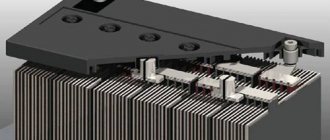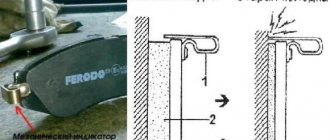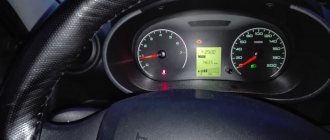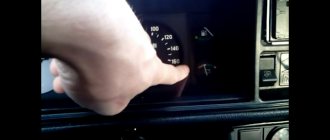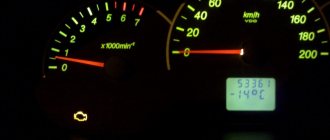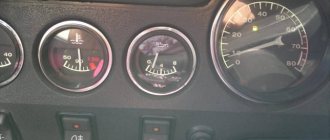Many people are concerned about why the injector icon on the instrument panel is lit. Some motorists ignore this Check, while the majority are trying with all their might to correct the current situation and identify the reason why the injector icon is on by making a diagnosis. We will now talk about where to start diagnosing.
To understand why the check injector is on, you need to understand a little about the design of the car. The car has an electronic control unit that controls the engine and other sensors. Therefore, if the injector light turns on, it means that some sensors have failed; the electronic control unit immediately begins to respond to them and sends a signal to the instrument panel - it turns on the injector check.
What does the Check Engine Light mean?
Sometimes it can be a very minor problem - for example, a loose gas cap or a faulty catalyst. However, you should not ignore the indicator signals under any circumstances, as this can result in serious problems.
The Check indicator may light up for various reasons.
Sometimes the cause of the indicator light may be poor fuel quality. So don’t be surprised if, after refueling at an unfamiliar gas station, you see the Check Engine light flashing.
Typically the indicator is located on the car's dashboard under the engine speed indicator. It is indicated by a schematic engine or a rectangle with the inscription Check engine or simply Check. In some cases, instead of an inscription, a lightning symbol is depicted.
Is it possible to continue driving while the light is on?
The brake pads are worn out, it's time for the next maintenance, the speed is switched incorrectly, low-quality fuel is used, the on-board voltage has dropped - all this can cause the Check indicator to light up. First of all, you should check the motor. If the reason for the signal to turn on is due to engine malfunctions, it is dangerous to continue driving.
The problem is aggravated by the fact that it is impossible to independently determine the malfunction of a modern internal combustion engine by smell or color. You should contact professionals who will use a scanner to identify the malfunction, if, of course, there is one.
A burning Check light may indicate various breakdowns - it is better not to ignore it
Therefore, if after restarting the car the light does not go out, you can only drive it to the nearest car service center. There they will conduct a comprehensive diagnostic of the engine and its systems.
Operating a vehicle with the Check Engine icon illuminated leads to increased fuel consumption, unstable engine operation, and decreased traction characteristics of the vehicle. Moreover, in this case, the car owner may lose the guarantee for car repairs.
Possible reasons for the check to light up
It doesn’t matter whether the injector has 8 valves or 16. The information in this section will help identify the problem on both types of engines. First of all, it’s worth figuring out what malfunctions are causing the light to light up. Sometimes you can identify a breakdown without even taking the car to a service center.
Broken spark plugs
A common problem, as spark plugs begin to not work as they should over time. There may be several reasons, but the most common ones are:
- Carbon deposits have accumulated, causing the spark to not be very good.
- The gap has changed due to burnt electrodes.
- Ceramic insulation is broken.
- Malfunction due to long-term use.
- Failure of high-voltage wires. The insulation on them may be broken, which disrupts the operation of the system.
To eliminate such problems, you need to change spark plugs and high-voltage wires.
The spark plugs must be unscrewed and inspected for carbon deposits. It is also necessary to check for the presence of a spark: it must be clear and strong enough. It is important that all candles spark approximately equally.
Throttle problems
This option is possible if the machine has been in use for a long time. The reason may be a malfunction of the mechanical part due to wear or carbon accumulation near the valve. Sometimes the opening and closing mechanism itself gets stuck.
The second reason, which is the most common, is failure of the throttle sensor. You can independently determine its malfunction, but it is quite difficult. It is much easier to take the car to a diagnostic shop, where they will check its performance.
Malfunction of the mass air flow sensor
The check engine on the VAZ 2110 very often lights up due to the failure of the mass air flow sensor. This option can even be called a disease of this model, so many people start checking with it. You can determine the problem yourself - gasoline consumption will increase very much.
If the check light is on and the car takes much more fuel than usual, you should immediately go to a car service center and have the mass air flow sensor diagnosed. This breakdown can be repaired quickly enough, and spare parts are inexpensive, so you shouldn’t drive with it and consume a huge amount of gasoline.
Use of low-quality fuel
If the check engine light comes on shortly after leaving the gas station, the cause is likely to be low-quality fuel. Because of it, the operation of the injection system is disrupted, detonation appears, and traction deteriorates significantly. The idle speed may also fluctuate, and failures during acceleration are often observed.
A loose or loose tank cap can also be a culprit.
The engine control unit receives information from sensors about improper operation of the system, and a light comes on on the panel. If this happens, it is better not to operate the car, but to drain the bad fuel and fill it with normal fuel. If the problem occurs on the road, you can drain most of it and add good gasoline. This also helps.
Sometimes you come across fuel of such poor quality that you have to flush not only the tank, but the entire system. If this is not done, the injector may fail, and repairs will cost many times more.
Low oil pressure in the system
This option is also often the cause of the problem. There may be several reasons:
- Failure to comply with oil change schedules. Over time, the lubricant loses its properties, becomes liquid and becomes heavily contaminated. This prevents the pump from creating the required pressure in the system.
- Poor quality oil. This is not difficult to determine, because the light will light up shortly after replacing the lubricant.
- The oil pump is broken or is not working properly. Circulation is disrupted or stops altogether, which is very dangerous. If you drive with such a malfunction, the engine will fail due to overheating.
The channels through which lubricant flows may also become clogged. Most often, the reason for this is untimely oil changes, so you should not ignore the established periods.
Why did the light come on and how to fix it
The main situations in which the indicator lights up and the recommended courses of action for the car owner:
Video: Check sensor lights up
Table: reasons for the Check engine light to come on and suggested actions
| When and in what cases does the “check” light come on? | Possible reasons | Suggested Actions |
| When driving, when accelerating | Harsh acceleration, faulty air filter | Replace filter, accelerate smoother |
| When the indicator flashes, the engine starts | The fuel in one of the cylinders does not burn completely; the gasoline either burns out in the exhaust pipe or immediately enters the catalyst | Replace spark plugs, check coil and armored wires, check timing marks |
| After refueling | Low fuel quality | Change gas station |
| When the ignition is turned on | Normal car reaction | Nothing should be done |
| After washing the car, engine, after rain | Water got into the Check engine wiring | Treat with WD40, dry, clean contacts |
| Cold | Knock sensor faulty | Replace |
| On a hot engine | Camshaft sensor faulty | Replace |
| At high speeds | Missing ignition coils or faulty crankshaft sensor | Replace coil or sensor |
| At idle | Throttle sensor malfunction | Replace |
| After replacing spark plugs | “Poor” combustible mixture | Change the octane number of gasoline to a higher one |
| After replacing the air filter | More air began to flow, the composition of the exhaust changed, the lambda probe reacted | Turn off the engine and start again |
| After replacing the timing belt | A terminal has come off from some sensor, most likely the air hose | Check terminals |
| After installing gas equipment | Fuel injector emulation is done incorrectly | Tune |
| After installing the alarm | Only one power line is connected to the turbo timer, the second one contains a temperature sensor, brake pedal and mass air flow sensor | Reset Check engine, connect both lines |
| After replacing the fuel filter | Low pressure filter installed | Replace filter |
| With a simultaneous increase in fuel consumption | Driving too long, oxygen heating up or poor quality fuel | Refuel with high-quality fuel and give the car a rest |
| On long climbs | Worn timing belt, faulty sensors | Check and replace |
| After replacing the ignition module | Module connection problems | Remove and reconnect the positive terminal from the battery |
| At sub-zero temperatures | Malfunction of the throttle position sensor or disconnection of its chip | Replace the device or replace the chip |
| When you press the accelerator pedal | Air filter clogged | Clean or replace the filter |
Air sensor
Another reason why the injector light is on on the VAZ 2115 panel is the mass air flow sensor, which is responsible for filling the cylinders with air. A malfunction of this sensor will be indicated by increased speed during idling up to 1500-2000 rpm or higher.
You may also be interested in: How to paint a car: some tips for painting a car
Another sign of a malfunction is when you take your foot off the gas pedal while driving, and the speed does not decrease or decreases very slowly. And during acceleration, jerks are noticeable.
Auto electrician website. Repair practice, electrical circuits, etc.
So, you have purchased a good, unpretentious car - a VAZ. But at one fine moment, the “Check Engine” icon lit up on the dashboard of your car, the literal translation is “check the engine”, in the slang of auto mechanics - “throw out the engine”, “meat grinder”, “check”, etc. (applies only to injection cars - Priors, Kalinas, etc.) The “check engine” icon itself, which does not go out after starting the engine, indicates a malfunction or electrical malfunction in the electronic engine control system (ECM). Many irresponsible citizens believe that in a domestic car the “check” should always be on, but this is not true; in a working car, no yellow or red indicators on the instrument panel should be on.
What malfunctions of the engine control system light the check?
A malfunction of the air flow meter MAF (mass air flow sensor) can light up the check lamp, errors P0102 or P0102, and a faulty flow meter also leads to such troubles as uneven engine operation, lack of acceleration dynamics, and high fuel consumption. As the name suggests, this sensor measures the amount of air entering the engine intake manifold and, based on this data, the control unit calculates the required amount of fuel. In general, this is the most important sensor in the engine control system; a lot depends on its readings. The air flow meter can either completely fail or distort the readings, which will lead to improper engine operation. A malfunction of the mass air flow sensor cannot always be easily diagnosed; the easiest way to diagnose it is to replace it with a known good one, taken from a neighbor. Connection diagram for VAZ mass air flow sensor.
A faulty intake air temperature sensor (built into the mass air flow sensor) causes errors P0112 or P0113. The air temperature sensor readings are used by the control unit to adjust the fuel mixture depending on the outside air temperature. The temperature sensor cannot be replaced separately from the air flow meter.
A malfunction of the catalyst “low catalyst efficiency” lights up the “check” lamp and has a slight, practically no effect on the behavior of the car. What is a catalyst and why is it needed?
A malfunction of the coolant temperature sensor causes the check ignition and errors P0117 or P0118, depending on whether it is a break or short circuit in the sensor or its wiring. It can be easily diagnosed with a multimeter; the repair manual gives the reference resistances of the sensor at different temperatures.
A malfunction of the throttle position sensor will lead to errors P0122, P0123 and emergency operation of the engine; the serviceability of the throttle position sensor is checked with a multimeter.
Lean mixture - error P0171 has many possible causes, first of all, low fuel pressure and further possible causes are clogged fuel injectors, air leaks, a malfunction of the air flow meter, a malfunction of the ignition system. We consistently diagnose all these reasons. For example, in this case the fuel pump turned out to be faulty.
Rich mixture - error P0172 may be due to a malfunction of the fuel pressure regulator (high pressure in the fuel system) we check by measuring the fuel pressure, leaking fuel injectors, faulty air flow meter, faulty oxygen sensor, stuck canister purge valve, problems with engine mechanics.
Broken fuel injector - errors P0201, P0202, P0203, P0204, the last digit is the number of the cylinder with the malfunction, the faulty cylinder does not work.
Fuel pump circuit malfunction - error P0230, this error indicates a break not in the fuel pump, but in the primary circuit of the fuel pump relay, most often the cause is an alarm lock or anti-theft lock.
Misfires - errors P0300, p0301, P0302, P0303, P0304. It is more correct to say misfires; using the crankshaft position sensor, the engine control unit measures the angular acceleration of each cylinder; if acceleration does not occur in this cylinder, “the counter is triggered,” when the counter overflows, the check light comes on or starts flashing with the corresponding errors. The most common cause is a malfunction of the ignition system - here the ignition coil turned out to be faulty.
A faulty knock sensor lights up the check with errors P0326, P0327, P0328. If the knock sensor malfunctions, the control unit goes into emergency operation mode and sets a safe (late) ignition timing angle. Affects dynamics and fuel consumption.
Crankshaft position sensor malfunction - error P0335. We check the crankshaft position sensor with an oscilloscope. In this case, the sensor stopped working after the engine warmed up.
Malfunction of the camshaft position sensor - error P0340, checked in the same way as the crankshaft position sensor.
P0500 - a malfunction of the vehicle speed sensor leads to decreased dynamics and increased fuel consumption.
Malfunction of the canister purge valve - error P0443, does not affect engine operation unless it is stuck open. The car's fuel tank is sealed, fuel vapors are collected in the canister and, when the engine is running, through the canister valve they enter the engine intake manifold, where they burn together with the working mixture.
Well, electrical wiring faults happen in these beautiful, moderately reliable cars; they manifest themselves in different ways, such as blown fuses due to a wire from the oxygen sensor stuck to the exhaust pipe, or torn wires from the crankshaft sensor, etc.
Hello, dear car enthusiasts! Probably many of you, while driving your car, have been spoiled a lot by the Check Engine light that lights up, then goes out, or even burns (without any obvious reason) with an “eternal flame.”
Knock Sensor
If a car has a knock sensor, it is responsible for dampening strong engine vibration through dosed fuel supply, thereby ensuring fuel savings (about 9%).
In addition to the above, the reasons may be: open or short circuit, mechanical damage to the wiring, slippage or breakage of the gas distribution mechanism, external overheating, increased induction fields, moisture, etc.
If you are not confident in your abilities, do not under any circumstances start troubleshooting, seek the help of professionals, especially since today ECU diagnostics are inexpensive, and based on the readable error code, it allows you to accurately identify the faulty engine unit.
No amount of savings on repairs will help you if you face the risk of serious problems.
What is this light bulb for?
It is simply impossible to imagine modern cars without special sensors. They are the ones who signal the emergence of problems and various malfunctions. If previously the owner of the car had to independently, so to speak, “manually” detect malfunctions, today this is not the case. The electronics took care of all the worries and there are quite a lot of such sensors on the VAZ 2110. The Check Engine light is a special light that usually glows yellow and helps the driver determine how the car's engine is operating. In normal mode, this same lamp lights up for a few seconds and immediately goes out as soon as the engine picks up speed. What to do when the light comes on and does not go out, even while the car is moving?
Note. As soon as the owner of a VAZ 2110 discovers that the engine light is constantly on and does not go out, he should immediately drive to a service station, if one is nearby. If not, then you need to turn off the engine and call a tow truck, as you can simply destroy the engine.
Let's go back to the 90s, when car owners knew that this sensor or lamp, in a simple way, could only report carburetor malfunctions or insufficient oil in the engine. Today the situation is completely different and if the lamp stays on, then anything is possible: incorrect engine speed, ignition problems, problems with the automatic transmission, etc. In a word, today this same sensor controls many parameters.
Oxygen sensor
An oxygen sensor is used to estimate the amount of oxygen in the exhaust gases; when it fails, fuel consumption will increase, and there will also be characteristic fluctuations during idling.
In addition to the sensors, the reason why the injector icon on the instrument panel is lit can also be mechanical damage to the timing belt, chain, etc. In general, you need to go to a service center with computer diagnostics or a motorcycle tester; in such a service station they can easily identify the reason why the injector Check light is on. If there is such a service in your city, they will immediately tell you the error code and identify which specific sensor requires replacement.
Video advice on why the injector icon is on:
Is it possible to drive when the Check Engine light is on?
If you see that the Check Light has come on, the first thing you need to do is stop and listen, take a closer look at the operation of the engine. If everything is normal, the speed does not fluctuate, there are no noises, the fluid level (fuel, oil, coolant) is normal, you can continue driving, but upon arrival, be sure to visit a service station to determine the cause of the Check Engine. If the problem is resolved, then the Receipt sign should disappear soon, this can happen in an hour or in a day or two. If this does not happen, then the problem is not solved and the search for the fault must be resumed.
If you are unable to independently find the reason why this error occurs, contact a service station, where specialists, using special equipment, can easily determine the cause of the error and help eliminate it.
Hello, dear car enthusiasts! Probably many of you, while driving your car, have been spoiled a lot by the Check Engine light that lights up, then goes out, or even burns (without any obvious reason) with an “eternal flame.”
What's wrong? Even many auto gurus cannot give an exact answer to the question why the injector light is on. Let's try to dig into the structural principle of the malfunction.
The injector light is on: what the sensors say
Crankshaft sensor - determines the speed of its rotation, position, and, consequently, the location of the pistons in the cylinder. The sensor operates based on electromagnetic induction.
If the injector is on because the crankshaft sensor is triggered, the consequences, if ignored, may be as follows: engine idling will be unstable, and if the sensor fails, the engine may stall and will not start at all.
The operating principle of the sensor is based on the Hall effect; the sensor is located on the front of the block on the input manifold side. Typical signs of a malfunction are increased fuel consumption and hesitant engine starting.
Source
temperature sensor
The injector indicator on the instrument panel may still light up if the temperature sensor has either failed or the temperature in the engine has become abnormal. If the temperature is not normal, then the ECU will switch the system to standby mode, after which the fan will turn on for additional cooling, and the idle speed will also increase.
If this sensor fails, then, as is the case with other sensors, fuel consumption will increase, and the engine will be more difficult to start.
What is the check responsible for?
So, the check must light up as soon as the vehicle’s SZ is turned on, and go out as soon as the engine starts. This indicates normal operation of the vehicle. Otherwise, if the check light comes on while driving or does not respond at all, diagnostics are needed at a service station.
Why does the check light come on when the ignition is turned on?
First, let’s find out what the purpose of the indicator is. It turns out that the check translated from English literally means “check engine”. In other words, if the indicator lights up while the vehicle is moving, it means that the car’s ECU is sending a clear signal to the driver that there is some kind of malfunction in the operation of the internal combustion engine.
Unfortunately, the ECU is unable to specify the problem. On the other hand, if you know which systems the check is responsible for, you can draw the appropriate conclusions.
Here, for example:
- The check can signal to the driver about a bad fuel mixture (fuel mixture) that enters the engine;
- If the number of engine revolutions does not coincide with the standard values in a certain driving rhythm of the car, the check lights up;
- The indicator controls the operation of the automatic transmission paired with the engine;
- It may indicate a problem in the ignition system.
Article on the topic: Do-it-yourself car muffler repair without welding
As you can see, the check engine controls the extensive functionality of various systems, and to determine a specific problem, you need to understand the specifics and test the listed components and systems.
As a rule, car services have special equipment designed specifically for such cases. For example, CDA is a computer diagnostic that makes it possible to specify the cause.
The check light does not light up when the ignition is turned on
Also, it can be extremely difficult to determine the extent of the defect from just one lightning of the check. For example, if a light comes on due to engine speed, this may not necessarily indicate problems with the engine itself, but may indicate an incorrect driving style by the driver. Many beginners cannot get used to a stable, even ride the first time; they constantly press the gas pedal or do not have time to add speed on climbs. As a result, a check is triggered indicating a problem.
So, it turns out that in one case the malfunction may be insignificant, in another it may be urgent and not require delay. If you find yourself on the road and the check light comes on, then you don’t need to open America, but go straight to the nearest car service center for diagnostics. If there is no service nearby, you can try to find out the reason yourself by rummaging around in the engine compartment.
What to do if the engine check light comes on
Firstly, you should remember that this light does not always indicate problems with the engine.
- If the “Check” lights up when starting the power unit and immediately goes out, this means that the engine is in good working order, and this is not a cause for concern.
- If the indicator does not go out, start to worry, since a breakdown has been detected in the engine. But you shouldn’t be too upset, since there is a possibility that they are insignificant, although critical ones are not excluded.
How to fix the problem?
First you need to identify the reason why the check light came on. Since there are many options, diagnosis is carried out first. It will help you identify a specific problem in order to understand what needs to be repaired and how. Procedure:
- You can try self-diagnosis. This function is available in the on-board computer. Everything should be done as described in the operating instructions. There are also error codes that can help you identify the problem. But this method is not very effective; it only helps sometimes.
- Computer diagnostics are much more accurate. With its help, you can determine the malfunction by code. It won’t be difficult to find a broken sensor or determine problems in the operation of components.
There are many videos on the Internet - they explain the reasons for the appearance of the check and show how to repair it. You can watch this video to better understand the topic.
Source

